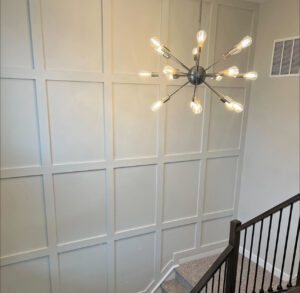Carmel homes impress long before you open the front door. From tree-lined streets around the Arts & Design District to the stately facades in west Carmel, exteriors sweep you in with charm. But once you cross the threshold, a surprising number of foyers feel unfinished. Standard drywall, base trim, and a mechanical light fixture can strip away the sense of arrival the exterior just built up.
If you’ve purchased a new home from popular builders like Pulte or Shoopman or any of the 30-plus active builders in Carmel. Your foyer is most likely spacious but bare. Its bones are strong, but it lacks the millwork details, layered trim, or built-in elements that say “custom.” That’s where intentional wall-trim carpentry and smart detailing come in. These moves don’t compromise warranty terms or alter structure, but they completely change the impression guests have when they step foot inside.
What follows are seven trim and carpentry strategies that pair directly with Carmel’s most common floor plans, turning that blank two-story space or modest entry hall into a true greeting.

What Model Homes Get Right and Wrong in Foyers
Model homes from Carmel builders are staged to impress. They lean on high ceilings, artful lighting, and curated furniture to distract from what the bones really are: plain painted walls. The open flow you see in a Pulte or Shoopman plan is appealing, but when you imagine living there day-to-day, you quickly notice the absence of refinement. Guests are welcomed by nothing more than open drywall.
Where they succeed is proportions. Builders often design foyers with soaring ceilings or pass-through spaces that connect directly to great rooms. These proportions naturally frame the possibility for future trim upgrades. But what builders leave out paneled walls, refined casings, or thoughtful moldings undermines the drama of that ceiling height.
By recognizing both the strengths and the missed opportunities of a standard builder foyer, homeowners can invest in upgrades that feel like they were meant to be there all along. It’s not about covering every wall in trim work, but choosing accent panels, moldings, and casings that give guests a sense of entry, not just a hallway shortcut.
Picture-Frame Molding Heights for 9–10 Foot Ceilings
Most Carmel new builds balance generously high ceilings with standard trim. A foyer in the 9–10 foot range begs for panel detail, but without guidance, homeowners risk proportions that feel off. Picture-frame molding delivers instant polish at these heights, provided spacing is set intentionally.
A professional trim carpenter knows that a panel five or six feet tall on a 10-foot wall feels stunted, while stretching one large panel wall-to-wall can appear blank again. Instead, breaking the wall into balanced squares or elongated rectangles creates rhythm that naturally leads the eye upward. In homes like Pulte’s “Greenfield,” a grid of vertical frames beneath a chair rail grounds the entry, while a taller stacked system can fill the space in Shoopman’s larger foyers without overwhelming them.
The beauty of picture-frame molding is its flexibility. Painted in white against soft gray walls, it adds traditional formality. In contrast, painting the entire wall, moldings included, a deeper tone produces a sharper, contemporary welcome. Either way, scale and proportion are the difference between trim that impresses and trim that looks like it doesn’t belong.
Sconce and Art Spacing Inside Trim Grids
Once framework is on the walls, lighting and art placement complete the picture. Builders rarely design foyers with sconces—most default to a single ceiling fixture. By adding wiring inside a trim grid, homeowners create controlled pools of light that elevate the experience of walking through the door.
Spacing is critical. Sconces placed inside trim panels guide the eye at human height, drawing attention downward so guests interact with the wall rather than just craning up toward a chandelier. Paired with framed art, mirrors, or even decorative hooks, the trim becomes functional display instead of just ornamentation. In Carmel foyers running nine feet wide or more, two sconces on each opposing wall create symmetry and make even a transitional hall feel intentional.
Couple this with framed artwork sized to the grid and suddenly the foyer becomes gallery-like, without a single drywall expanse left untouched. Imagine walking into a Shoopman home where a blank wall is replaced with trim, sconces, and curated family art. The foyer now tells a story while still carrying the durability that wood trim provides.
Bench and Hidden Shoe Cubbies Behind Paneled Walls
Families in Carmel juggle busy schedules, multiple cars, and endless bags. The foyer often doubles as a touchdown spot, but most builder packages leave you with nothing more than floor space. That’s where combining trim with function delivers the biggest wins.
A built-in bench carved into paneled walls gives guests and family members a natural landing spot. Behind or beneath that bench, hidden compartments can house everyday clutter—shoes, bags, or even seasonal décor. This keeps the entry looking calm and refined when you walk in the door. Consider an entry in Pulte’s “Ashton” plan: a bench beneath board-and-batten trim stretches the narrow hall, while soft-close cubbies tuck gear out of sight.
With a custom trim carpenter, these benches integrate directly into the grid system, so they don’t look like afterthoughts. The seat flows with the molding height, the panels wrap seamlessly behind, and the cubby doors mimic the wall pattern. From the front door angle, what looks like refined carpentry is also highly practical storage.
Door Casing Upgrades That Read “Custom” from the Street
Before guests even step inside, they’re already looking at one focal point: your front door casing. Builders in Carmel often stick with plain 2 ¼-inch profiles—fine in function, but narrow against wide siding or tall entryways.
Upgrading door casings around main entries instantly changes perception. A Shoopman craftsman-style exterior paired with strong five-inch casings capped by a pediment trim looks higher tier from the curb. On Pulte’s more transitional designs, a clean but thicker square casing painted crisp white immediately reads as intentional rather than builder-default.
What makes a casing upgrade stand out is continuity. When that expanded trim wraps inside, carries along the foyer side windows, and connects to baseboards, the entire door wall takes on a richness that boosts curb appeal and interior impressions together. It’s the most visible millwork upgrade and often the first detail neighbors and friends comment on.
Wainscot and Board-and-Batten as Vertical Anchors
Flat drywall foyers can feel endless. Adding vertical elements like wainscot or board-and-batten trim grounds the walls and gives texture where there was none. Many Carmel foyers benefit from a low three-foot wainscot topped with a chair rail, while taller entries welcome full-height battens.
Take a two-story foyer Pulte offers in North Carmel. A tall board-and-batten wall painted in contrast to the trim helps anchor furniture or artwork, preventing the space from feeling cavernous. In smaller Shoopman foyers, a traditional paneled wainscot balances modest proportions without overwhelming sightlines into the great room.
These vertical details also protect walls. The foyer is a high-traffic zone, and trim absorbs scuffs far better than painted drywall. With kids, pets, or frequent guests entering, board-and-batten becomes both a practical and visual upgrade.
Crown and Ceiling Trim That Pull the Eye Up
Carmel foyers often boast tall ceilings, but drywall transitions can feel unfinished. Crown molding or ceiling trim provides the final layer, linking the walls to the height above.
Crown on a 9–10 foot wall softens the transition from wall to ceiling, while larger Shoopman spaces may even benefit from coffered ceilings framed by beams. Adding subtle trim to define the ceiling plane changes how light plays through the space, and it’s one of the upgrades that guests sense instantly without even knowing why the room feels more refined.
Colored ceiling insets bordered by molding also offer personality. Imagine a foyer where pale blue sits inside a cream trim grid above, setting tone before you take a single step farther into the house. Crown and ceiling treatments frame the entire entry, turning what was once empty air into part of the design.
Why These Moves Work in Carmel
A Carmel new build is rarely small on space. The layouts are smart, the sightlines are clear, and builders like Pulte or Shoopman ensure the first impression is generous. But those impressions can fall flat without detail. Trim carpentry corrects that by layering proportion, scale, and function where drywall once left emptiness.
Picture-frame moldings scaled to ceiling height, sconces inside trim grids, benches with storage, and stronger casings all serve to activate the first 10 feet of your home. Nothing is structural, but the upgrades make the difference between a generic entry and one that feels custom from the first step.
A foyer sets the tone—not just for visitors, but for how you experience your home every day when you arrive. Carmel homes deserve entries that reflect their exterior curb appeal, and wall trim carpentry is the surest way to make that happen.
Ready to See Carmel Foyer Transformations?
At Radford Woodworks, we specialize in foyers that work as both welcome centers and design statements. From picture-frame moldings to bench cubbies and door casings, we tailor solutions to Carmel floor plans from builders like Pulte, Shoopman, and dozens more across the city.
If you’d like to schedule a measure or discuss custom trim ideas for your foyer, call (317) 739-8555 or book through radfordwoodworks.com/contact.
The exterior already impresses. Make sure the first step inside does the same.






